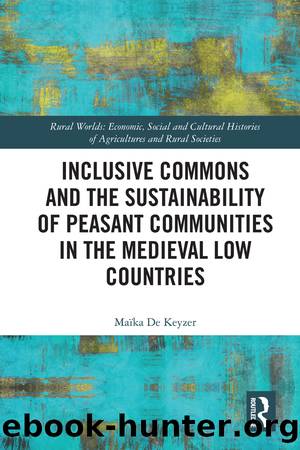Inclusive Commons and the Sustainability of Peasant Communities in the Medieval Low Countries by Maïka De Keyzer

Author:Maïka De Keyzer [Keyzer, Maïka De]
Language: eng
Format: epub
ISBN: 9781138054042
Publisher: TaylorFrancis
Published: 2018-03-10T00:00:00+00:00
A Fair Share of the Pie: The Common Denominator
The second criterion we proposed for a successful common is a fair division of the benefits to be drawn from the common amongst its community of users. For most CPIs this distribution was very important, as is shown by the abundance of rules regulating it. According to Rodgers et al., a fair distribution of benefits was vital to secure âgood neighbourhoodâ, which was one of the most vital issues for CPIs.41 In general scholars have considered the distribution of fixed and maximum shares of common pool resources as the main principle to distribute benefits fairly, while maintaining a sustainable management.42 Limitations on use rights predominantly took the form of limits on herd sizes, but could equally be applied to other types of use rights, such as timber, peat and hay harvests. Winchester has distinguished two principles that could be employed to control and limited the number of livestock on any common pasture. First, there is the rule of âlevancy and couchancyâ which allowed a commoner to place on the commons as many animals as he was able to sustain over the winter from the produce of his holding. A second option was the introduction of stints. CPIs that applied stints allowed each household to put a fixed number of animals on the commons, regardless of their socioeconomic status or landownership where levancy and couchancy was more focussed on equitable access. Not all households held the same privileges, but their grazing rights were in relationship with their economic needs. Stinting actively responded to the carrying capacity of the common field. Rich community members had reduced privileges, but the benefits were distributed in a purely egalitarian way.
A third distribution strategy was possible in which no prohibitions were introduced and no strict numerical limitations were applied, but without creating an open access situation. In this third strategy the benefits to be obtained from the commons were clearly defined and measures to prevent overexploitation were employed, but community members were not granted a fixed share of the benefits. This meant that different types of resources and diverging quantities could be used per household or member. In all three options communities introduced rules to limit overexploitation. In addition, according to McCarthy, engaging in collective action immediately restricts individual peasants from overstocking and has a negative effect on herd sizes.43
The use of fixed stints and even restrictive stints per household is often considered to have become dominant way of allocating resources from the fifteenth and sixteenth centuries onwards. Only upland regions, or areas with vast commons such as Sweden, refrained from introducing such restrictions and then because of the extent of their wastelands.44 Nevertheless, the third option was more common than assumed. For example as much as 46 per cent of England and Wales remained stint-free.45 The Campine was also stint-free, despite the fact that it was exactly the sort of area where one could have expected stinting to have been introduced.
If we take a look at the
Download
This site does not store any files on its server. We only index and link to content provided by other sites. Please contact the content providers to delete copyright contents if any and email us, we'll remove relevant links or contents immediately.
International Integration of the Brazilian Economy by Elias C. Grivoyannis(75077)
The Radium Girls by Kate Moore(11621)
Turbulence by E. J. Noyes(7702)
Nudge - Improving Decisions about Health, Wealth, and Happiness by Thaler Sunstein(7244)
The Black Swan by Nassim Nicholas Taleb(6770)
Rich Dad Poor Dad by Robert T. Kiyosaki(6179)
Pioneering Portfolio Management by David F. Swensen(6081)
Man-made Catastrophes and Risk Information Concealment by Dmitry Chernov & Didier Sornette(5650)
Zero to One by Peter Thiel(5494)
Secrecy World by Jake Bernstein(4389)
Millionaire: The Philanderer, Gambler, and Duelist Who Invented Modern Finance by Janet Gleeson(4099)
The Age of Surveillance Capitalism by Shoshana Zuboff(3989)
Skin in the Game by Nassim Nicholas Taleb(3968)
The Money Culture by Michael Lewis(3849)
Bullshit Jobs by David Graeber(3834)
Skin in the Game: Hidden Asymmetries in Daily Life by Nassim Nicholas Taleb(3726)
The Dhandho Investor by Mohnish Pabrai(3561)
The Wisdom of Finance by Mihir Desai(3526)
Blockchain Basics by Daniel Drescher(3330)
